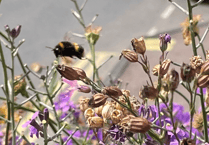I have been heartened by the amount of bees and butterflies I have seen recently, especially as I commented on their obvious absence only a couple of months ago. I have been far less enamoured by the vast amount of wasps everywhere. I do try to ‘love’ – or even tolerate -them too, but they don’t help themselves by just being so randomly annoying. Even when you don’t want to get involved, they still seem to want to fight, and after finding 8 wasps nests in various gardens over the last couple of weeks, I have become super-vigilant. They’ll get even more badly behaved once they start on the apples and fallen fruit. That’ll be something to look forward to. Not.
Anyway, I have loved seeing the amount of butterflies on buddleias. Often thought of as a weed, I have always somewhat secretly held a torch for buddleias as a hard working, generous plant. But they do need ‘tough love’. They need to be planted in the right place and pruned properly and will then reward you with masses of colour, beautiful scent and a guaranteed source of food for bees, butterflies and other pollinators. Of course, it is the fact that they are literally butterfly magnets, which gives the shrub its common name of Butterfly Bush.
Despite being a supporter of the shrub even in my late teens, I could never remember how to spell it for my planting plans or columns. Dad told me that it was named after Reverend Buddle, and you just added an ‘ia’ on the end of his name. You will occasionally see it spelled ‘Buddleja’ but the addition of two letters after the Reverend’s surname remains the same principle.
Buddleia davidii and Buddleia alternifolia are probably the most popular butterfly bushes, but they differ in their growth habit and flowering patterns. Buddleia davidii is known for its large, showy flower panicles on upright, arching branches, while Buddleia alternifolia has slender, arching or weeping branches with flowers produced along the length of the previous year's stems. I think out of the two, the davidii varieties are the most often seen as they have the greatest number of options to choose from. Over time, plant breeders have developed new cultivars of butterfly bushes ensuring there is a range of flower colours, shapes, and sizes for every garden and even balcony. Most buddleias can reach a giddy height and width of 12-15 feet making them great doers for big spaces, but the newer, more compact cultivars are ideal for planting in containers.
There are apparently over 140 distinct species of Buddleia and I can only encourage you to check out which variety, size and colour would be best suited to your garden but here are a I’m sure your local garden centre will always stock a selection of Buddleias but one of the best places to see them all online is at www.championplants.co.uk/collections/buddleja-plants with over 60 varieties available to buy.
As butterfly bushes can and often do grow to well over 10 feet tall with a similar spread, it’s important to keep them properly pruned. Most – with the exception of the alternifolias (as mentioned) should be fully pruned at least once a year, ideally in early spring, once the chance of frost has passed. March is often ideal, but go with the weather as frost may harm the new growth.
Following intense spring pruning, you should also deadhead the old and dead blooms immediately after flowering to encourage new blooms – it may seem daunting but I always find it quite therapeutic working amongst the heady scent and dining butterflies.




Comments
This article has no comments yet. Be the first to leave a comment.